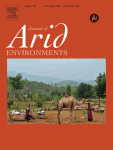Ver ítem
- xmlui.general.dspace_homeCentros Regionales y EEAsCentro Regional Patagonia SurEEA Santa CruzArtículos científicosxmlui.ArtifactBrowser.ItemViewer.trail
- Inicio
- Centros Regionales y EEAs
- Centro Regional Patagonia Sur
- EEA Santa Cruz
- Artículos científicos
- Ver ítem
Biomass, carbon and nutrient storage for dominant grasses of cold temperate steppe grasslands in southern Patagonia, Argentina
Resumen
We hypothesized that different dominant grasses species display contrasting nutrient accumulation, allocation and conservation strategies. Also, we expect a distinctive pattern of carbon and biomass partitioning according to plant sizes. The aim was to quantify the amount of biomass, carbon and nutrients in both above- and belowground components for four dominant grasses in grasslands steppe. We analyzed biomass, carbon and nutrients (N, P, K, Ca, Mg and
[ver mas...]
We hypothesized that different dominant grasses species display contrasting nutrient accumulation, allocation and conservation strategies. Also, we expect a distinctive pattern of carbon and biomass partitioning according to plant sizes. The aim was to quantify the amount of biomass, carbon and nutrients in both above- and belowground components for four dominant grasses in grasslands steppe. We analyzed biomass, carbon and nutrients (N, P, K, Ca, Mg and S) of each dominant grass species corresponding to different sizes and separated in components (green and senesced leaves, pseudostem, and fine and coarse roots). Total biomass accumulation for individual grass plants was affected by plant size and species and ranged from 15.4 to 684 g dry matter plant1. The biomass root/shoot ratio ranged from 0.28 to 3.40. Total nutrient concentration generally graded in all species the following order: green leaves > fine roots > pseudostem > coarse roots > senesced leaves. Storage of any particular nutrient varied depending mainly on species. Mean nutrient resorption efficiency varied according to the growing season and specie being maximum for K and minimum for Mg. The equations developed for individual grass plants could be used to assist quantitative predictions of biomass, carbon and nutrient accumulation per hectare.
[Cerrar]

Fuente
Journal of Arid Environments 74 (1) : 23-34. (January 2010)
Fecha
2010-01
Editorial
Elsevier
ISSN
0140-1963
Formato
pdf
Tipo de documento
artículo
Palabras Claves
Derechos de acceso
Restringido
 Excepto donde se diga explicitamente, este item se publica bajo la siguiente descripción: Creative Commons Attribution-NonCommercial-ShareAlike 2.5 Unported (CC BY-NC-SA 2.5)
Excepto donde se diga explicitamente, este item se publica bajo la siguiente descripción: Creative Commons Attribution-NonCommercial-ShareAlike 2.5 Unported (CC BY-NC-SA 2.5)

